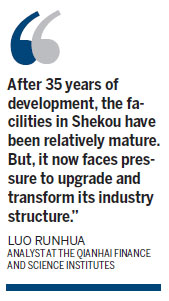Shekou takes its place in Guangdong's FTZ
Updated: 2014-12-30 09:50
By Chai Hua in Shenzhen(HK Edition)
|
|||||||||
Shenzhen's Shekou Industrial Zone (SIZ) has, surprisingly, joined the proposed Guangdong free trade zone (FTZ), according to an announcement by the National People's Congress on Dec 26.
Experts believe that the combination of Qianhai and Shekou will effectively facilitate the convenience and liberalization of the area's financing and trading services, leading to more startups and investments from Hong Kong, Macao and overseas.
The 10.9-square-kilometer SIZ, located in the Nanshan district, was developed solely by Hong Kong-based China Merchants Group (CMG) in 1979 - well before the Shenzhen Special Economic Zone came into being.
Shekou was referred to as the "black horse" by the mainland media when it comes to joining the Guangdong FTZ, but Yang Tianping, general manager of China Merchants' Shekou Industrial Zone Co Ltd, described the latest development as "a natural thing".
"Shekou has excellent logistics and port facilities," explained Yang. "It's only being complementary to Qianhai if both are included in the Guangdong FTZ."

CMG had brought up the idea with the Shenzhen and Guangdong authorities, drawing a positive response from them, according to Yang.
Department of Commerce of Guangdong Province said taking the SIZ into the FTZ can combine its advantageous industries, such as shipping logistics, with Qianhai's financing and information industries, with the aim of raising the overall competitiveness of both the FTZ and the Pearl River Delta region.
Besides the SIZ, the Chiwan Container Terminal, which is only 20 nautical miles from Hong Kong and the gateway linking the world with the Pan Pearl River Delta region, is also included.
Experts believe Shekou's inclusion is certain to benefit Qianhai. "Such cooperation will create more diversified business activities for Qianhai," said Guo Wanda, executive vice-president of Shenzhen-based think tank, the China Development Institute.
"The Shekou Industrial Zone can rapidly provide facilities for the development of Qianhai's emerging industries, and facilitate Qianhai's finance, technology, logistics and service industries' development," said Guo.
Luo Runhua, an analyst at the Qianhai Finance and Science Institutes, said: "Shekou has established an international residential environment, which will help Qianhai attract high-end tenants from abroad." According to CMG, about one-third of foreigners in Shenzhen currently live in Shekou.
Luo believes that Shekou's participation will further help its revival: "After 35 years of development, the facilities in Shekou have been relatively mature. But, it now faces pressure to upgrade and transform its industry structure. The FTZ policies will play a leading role in the area's economic improvement."
China Merchants Bank, Ping An Insurance and many other top enterprises had already firmly established themselves in Shekou, whose reformation experiments have been extended to the whole country. But, the district has gradually quietened down as more and more special and economic zones are developed.
In 2009, Shekou decided to upgrade and transform its economic development model in an effort to create a brand new industrial and business zone.
Though cooperation will be advantageous to both sides, the management between the two sides' authorities has triggered concern. At present, Shekou adopts an enterprise-style management system by the CMG, while the Qianhai administration is a statutory body not geared to making profits.
Luo estimated that the Guangdong FTZ will have a unified institution to coordinate management.
The CMG has actually participated in the development of Qianhai from the very beginning.
Within Qianhai's 15-square-kilometer land, CMG owns a bonded port area of 3.9 square kilometers, accounting for a quarter of the total area.
grace@chinadailyhk.com
(HK Edition 12/30/2014 page8)